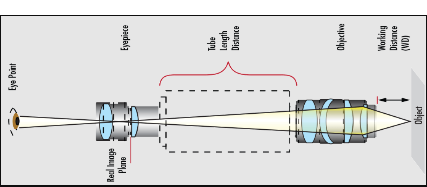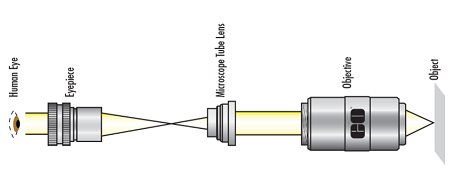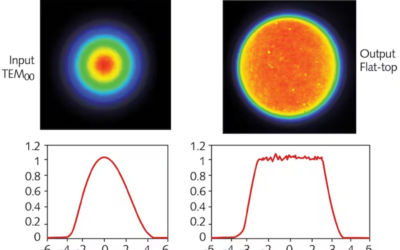Traditional Microscope system
Traditional microscope systems consist of two main optical elements: a microscope objective and an eyepiece. The microscope objective is placed close to the sample that we want analyzed. The distance between the objective lens and sample is called the working distance and depends on the magnification of the objective lens. The objective lens will create a real image somewhere in the tube. This image is usually referred to as an intermediate image. The eyepiece is then placed such that it will create a virtual image out of the intermediate image. This allows the user to relax their eye and focus away from their near focal distance reducing strain on their eyes. Figure 1 shows a simplified version of an finite microscope optical layout.

Figure 1. Finite corrected microscope. Figure from Edmund Optics
What is an infinity Corrected Lens
In the last 10-15 years, there has been a shift in the design of microscope systems. Many new and complex microscopy applications require additional components such as filters, dichroic mirrors, and similar elements. We refer our readers to this previous blog about scanning and fluorescent microscope design
One limitation of finite microscope is that the tube length distance is fixed (usually at 160 mm) and if we add any elements in the tube, this distance will be affected and we will need to redesign our eyepieces and objective lenses. This can increase cost and may introduce unwanted aberrations.
One solution is the introduction of infinity corrected lenses. In this microscope’s optical design, the objective creates the image at infinity and a new optical element called the tube lens creates the intermediate image that is picked up by the eyepiece. The main consequence of this small change is that we don’t have a set distance between the objective lens and the tube lens (although it is usually set somewhere between 160mm to 200mm) and it is possible to add optical elements in between without affecting the quality of the image. Figure 2 shows an infinity corrected system

igure 2. In an infinity corrected system, the objective lens creates a series of collimated rays and the tube lens creates the intermediate image. Figure from Edmund Optics.
5 Advantages of Infinity Corrected Lenses
Magnification remains constant regardless of the distance between the objective lens and the tube one.
It is possible to insert flat plates between the objective and tube lens without any significant change in image quality.
You can introduce additional optical components like filters, polarizers, and beamsplitters without affecting the image.
You are not limited to a mechanical length tube of 160 mm
Aberrations can be controlled either by the objective lens, tube lens, or both.





